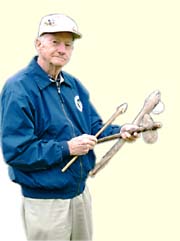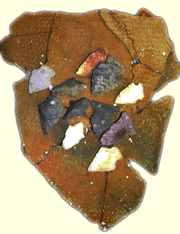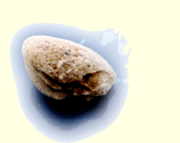
|
 |
||||||||||||||||||||||||||||||
|
|||||||||||||||||||||||||||||||
Following Footprints through TimeArcheologist Dick Johnson Knows Who Was Here
Dick Johnson knows who lived in your neighborhood thousands of years before you. In the farms, creeks and rivers, he reads a record more lively than any school history book. “It started way back when I was 13 years old,” he told me as we talked in his rambler home in Mimosa Cove, where relics of the past are as common as knick-knacks in other houses. “That was back in Illinois in 1935. One day when my grandfather took me fishing in Southern Illinois, he told me that he was part Cherokee, and that piqued my interest. This was the same day I found an Indian axe in the field we were crossing.” The young Johnson wanted to stop and find more artifacts, but his grandfather pooh-poohed his enthusiasm. “No one is interested in old Indian rocks, there’s so many of them,” he recalls his grandfather saying. But Johnson was interested. When fishing was over, the boy returned to that field to find his first arrowheads. World War II transformed Johnson from a student to a maker of history, piloting a B17 bomber. He’s written a book, Twenty-Five Milk Runs, chronicling that chapter of his life. But when the war was over, Johnson still loved the past and still sought its earthen record. In 1949, he moved to Washington, D.C., to live with his uncle and to seek work. Chesapeake Bay and boating recruited him to Deale, where he continued his quest. The rest is history. “Dick Johnson is fantastic,” says Wayne Clark, who oversees Maryland’s state museums. “He’s one of America’s Greatest Generation-type heroes, son of a tenant farmer in the Midwest who achieved amazing things. “He’s president of the Archaeological Society of Maryland and for a decade or more was president of the Anne Arundel chapter. His new book on his life is a fantastic read.” But I didn’t know any of that when I knocked on Dick Johnson’s door. Mysteries of the PastI’d gotten to know a thing or two about the lost lives of Egyptians and Greeks in visiting Smithsonians on lunch hour over all the years I’d worked in D.C. At home, the History and Discovery channels fed my interest. But I knew next to nothing about who our neighbors were 500 to 8,000 years ago, who’d lived, farmed, married and fought for the land I live on. Until I heard Johnson at a Sunday afternoon talk and saw his collection of projectile points, axes and bow and arrow. I wanted to know more. “Where did you find all these things?” I asked. “Right here in Southern Anne Arundel County,” he replied. “What Indians were living here then? Who were they? How do you know their names?” Dick started to explain. East Coast Indians were all nomadic and moved with the seasons. Here, they lived on the water’s edge, where they fished, crabbed and lived off shellfish. Wading into the clear water, they could see oysters everywhere. They ate oysters year round; no R months for them. When they traveled, they took dried oysters along as a chewy food. Indians left oyster-shell middens at each site they visited. A midden site found at Piney Point covered 30 acres and was 30 feet deep. “That must have been one big pow-wow,” I laughed. “But who were they? And where did they go?” Johnson’s findings came from two main tribes, the Algonquians and their enemy, the Iroquois. The Iroquois lived near Baltimore, but they traveled great distances, killing other Indians and gaining hunting land. The Iroquois traveled on foot from Baltimore to St. Mary’s County, fighting with the local Algonquians. Dick calls the Algonquian “our Indians.” His next statement came as one of the many surprises in store for me. “The Indians did not use bow and arrows until around 1,500 years ago,” he told me. “In earlier years, they used darts and spears for hunting and fighting off the Iroquois.” Then he began to reveal the mystery of past spirits. The Past Is a Long TimeIf I found an arrowhead, I wouldn’t have any idea whether it was 500 years old or 5,000. If I found one. I grew up in Punxsutawney, Pennsylvania, a town with an Indian name where most everyone has found a relic or two. My dog and I traipsed the woods for years for arrowheads, and we came up empty handed. When I began talking with Johnson, I saw the Indian past as a big blur. “I’ve lived in Southern Anne Arundel County 15 years,” I said. “When were Indians last here? Four hundred years ago? “There weren’t any Indians here 400 or 500 years ago,” Johnson told me. “That may be why none of our creeks have Indian names. If whites had been here, wouldn’t they have recorded the Indian names? I’m guessing that’s why we have English names for our waters.” I know that like my home town, Northern Anne Arundel County and Southern Maryland have Indian names for their waterways and some towns. Patapsco and Patuxent are Indian names. “What happened to our Algonquians?” I wanted to know. “Where did they go?” “No one knows,” he said. His guess is that the ferocious Iroquois scared them away. On the other hand, he said, “there’s lots of evidence to show that Indians were here 1,000 years ago and earlier,” he said. “My findings come mostly from the Late Woodland period.” I had to stop him there. “What do you mean by Woodland? And what’s this Archaic you’re talking about?” Both words describe historic periods of time, he explained. “First is the Early Archaic, 8,000 to 10,000 years ago, before there was a Chesapeake Bay. Then the Transition Period or Middle Archaic ranged from 4,000 to 8,000 years ago. Next came the Early Woodland Indian, and that would be just before the time of Christ. The Late Woodland ended with the arrival of Europeans,” Johnson said. Most of his findings come from the Early to Late Woodland, 500 to 1,500 years ago. “From Deale to Mayo, Indians left a trail of artifacts for us to find,” Johnson said. “As you travel down Route 258, you’ll pass several good areas where Indians once trod. Tracy’s Creek, once called Herring Creek, was much deeper than today’s creek and probably navigable. The creek provided fish and oysters and a good stopover site.” Here’s some of what he’s found along that route. From Indians …Since the 1960s, Johnson has explored Deale farms along Route 258. At Sherbert Farm, he detected markings that suggested a large burial site. He did not excavate the field. But earth stains from posts rotted in the ground were as clear to him as footprints. Only if the site is endangered by development will it be dug to preserve what may lie hidden beneath those earth stains. “For us archeologists,” he said, “such stains are footprints in time.” The stains, he explained, are left in the soil from a wooden structure that had been Johnson thinks the stains mark an ossuary. “Ossuaries on the Potomac River closer to Virginia have contained hundreds of skeletons,” he said. On the Rhode River, iron oxide that had been painted on burned bones was the clue that led to an ossuary. The red-stained earth revealed the skeletons as the cliff-side Indian burial site crumbled into the river. “So an ossuary is a cemetery of sorts?” I asked. “Just like a cemetery without headstones,” he answered. “But I haven’t found any myself.” Near Parks Liquors and the nearby Howard’s Farm, Johnson found more tangible evidence of generations of lives before him. “Artifacts were scattered over two dozen acres,” he said. Walking the fields as he had as a boy, he searched the “plow zone,” dirt less than a foot deep, the depth of a plow blade. From that zone, he turned up things that were very, very old. How did he know how old? I wanted to know. “I found a six-inch axe here,” he explained. The Archaic Indians made a groove all the way around their axe blade, while the Middle Woodland made a three-quarter groove around their stone axe heads. The later Woodland had no groove at all. Johnson’s axe was grooved all the way around, making it Archaic. The land also revealed rocks once used for weapons. The rocks showed scars from years of plows scrapping over them, turning them over and over as the plows moved across the land. Another unusual feature of the area was the large number of thumbnail-sized scrapers made from flint and quartz. They had very sharp edges, but so far, he says, nobody can figure what those sharp edges were used for. Nearer Rockhold Creek in 1988, landowner Merle Howard found a stone pestle about 11 inches long. He found no mortar bowl, just the pestle that Indians had used for grinding corn, grasshoppers and sumac berries, which made a good drink. Scratches on the pestle showed that previous owners had also used it as a hammer and a whetstone. Howard gave Johnson not only the pestle but also a large quartz crystal. Staring into the crystal, Johnson imagined the area as a quarry because of all the quartz and quartzite artifacts turned up over the years. … To ColonistsOver the millennia, Indians were followed by European settlers on the shores of Chesapeake Bay. On the western portion of the Route 258 farms, Johnson happened upon a colonial refuse pit. It had never been excavated and was filled with a jumble of both colonial and Indian artifacts. As well as thumbnail scrapers, Johnson found colonial ceramic shards, button backs, bottle pieces and a five-and-a-half-ounce glob of melted copper. Indians didn’t use buttons, and colonists didn’t use scrapers, but both smoked pipes. Indians introduced smoking to Europe, and by the time early colonists arrived in Chesapeake Country, they had already acquired the habit. The pit turned up pipe stems and a few bowls from both peoples. “How do you know whether they are from Indians or colonists?” I wanted to know. “All the white pipes we found were colonial,” Johnson told me, leaving me just as puzzled. “They’re made from Kaolin clay, a white mineral clay found near St. Mary’s. The Indians’ pipes looked like the colonial pipes except they were brown. They were made out of local clay, the same clay used in local pottery.” Color is not the only clue to who smoked what. Age also tells. To tell how old the stem is, archeologists look at the size of the stem opening, or bore. Early pipe stems have a large bore, which would make for a stronger smoke. As technology improved, the stem got a smaller bore. “Geologists now have a regular gauge that is used to measure openings or bore holes, and also we have carbon dating,” Johnson said. Back to the PresentBack in the present, Johnson seemed to be reading my mind. “Now don’t run down Route 258 thinking you can find all sorts of artifacts,” he said. “The area is now a sod farm.” “Maybe I’ll luck out some day,” I teased, “because I buy loads of sod each spring when I’m fixing up my damaged yard.” Digging on private land requires getting the owner’s permission, the approval of state archeology department and recording the complete dig. “If the dig is not recorded it is no better than pot hunting or robbing,” Johnson said, “because the site is lost.” Pipes and PotsFrom remains of ossuaries to oyster shell middens, Indians left their footprints on the land. Galesville revealed oyster-shell middens so thick that farmers ploughed around them because it took too much effort to plow through. Pottery shards littered the area. “Does this mean that a huge clan lived here?” I ask. “No. Just that the area was used over and over again for a thousand years or more as a good food source,” Johnson replied. “Indians could possibly have been occupying this area for over 10,000 years. Since before we had a Chesapeake Bay as we know it.” “And the pottery shards mean what?” “They tell archeologists that Indians spent time in an area. Since clay was so available everywhere they traveled, leaving pottery behind didn’t matter. On settling in a new area, they would begin making new pottery. Pottery acted as a map or an identifier of what tribe passed through each area.” “How is that?” Like pipes, he explained, pots were made out of different clays. Found by the thousands and compared, potshards are identified by thickness and design. Designs such as scratches in wet clay, rope twists or netting designs help identify age, tribe or clan. Middle Woodland Indians designed their pottery by placing wet netting on wet clay. Their pottery can be dated to before the time of Christ. Potomac Creek pottery designs were scratched into wet clay; these were the last pots the Indians made before the white man arrived with iron pots. Every springhead or fresh water source gave Johnson Indian pottery. “If you can locate a springhead, you could find pottery shards,” he told me. Rebekah at the WellPottery, oyster shells and pipe stems weren’t the only identifiers of those who trod across these lands. Johnson turned up gunflints from the English and French in Galesville’s Cedar Park area. Ships arriving near Galesville possibly carried the flint in their ballast. When they landed, the flint was thrown out and tobacco destined for Europe refilled the empty storage area. Johnson discovered evidence of a tobacco inspection station when Mimi Bridgeman Murray asked him to survey her Cedar Park land. He searched for years, until down at the water’s edge underneath oyster shells, he stumbled on chips of brick, which indicated colonial use. Walking to the shore, he discovered earthworks and a groove that looked like a ramp where colonists rolled tobacco hogsheads — great wooden barrels packed with 1,000 pounds of tobacco — down to waiting boats. Not only did he find the tobacco inspection station, he also found a gem. Dick’s gem and favorite find at Cedar Park is a small black statue about an inch and a half tall of a woman sitting at a well. Johnson says he calls her Rebekah, from Rebekah at the well of Genesis 24: 12-15. As I looked at the exquisite, small figure, I too saw a remarkable likeness of a woman clothed in a tunic sitting near a well with her water jugs. Dick thinks Rebekah was broken off a lid, perhaps of a tankard owned by a colonist. She is one artifact he has kept for himself. Beautiful BladesAt the end of Contees Wharf Road off Muddy Creek Road, Dick found another mixed Indian and colonial site containing artifacts as new as 1,500 years and others older than 8,000 years. One large ungrooved axe had recently been exposed by a plow; Anne Arundel County has it now. Johnson believes Indians used this area as a summer camp. Come winter, the Indians would move upstream to trap beaver and make more weapons to ward of the raiding Iroquois. Searching the riverbed, a 20th-century resident discovered what Johnson describes as “a cache of Indian blades of varying colors, really beautiful blades.” Smoking pipes and projectile points were recovered from the river, as well. “They must have been brought to this area for thousands of years. One was a perfectly chipped blade about eight inches long made from flint from Indiana,” Johnson says. “It’s gorgeous stuff, unbelievable.” You can see the eight-inch flint blade for yourself on display at Jefferson Patterson Park in Calvert County. Remains from Ancient MealsA three-quarter grooved axe discovered by the Zang’s son in early l970 alerted Johnson to relics at Zang’s Farm, one-quarter of a mile north of Galesville. Walking the farm, Johnson discovered three kernels of corn in the remains of what appeared to be a fire pit. As in Galesville and Cedar Park, Zang’s farm holds artifacts of all phases. Carbon dating will prove if the corn comes from the Late Woodland period or even earlier. “Digging farther, I discovered stone artifacts 8,000 years old,” he said. Soil stains also revealed a medium-sized colonial house, about 12 feet by 12 feet. Three kernels of corn must have whetted Johnson’s appetite because, he says, “I found remains of a meal up by Mayo Elementary School near Selby Bay.” Construction led Johnson to this find. A bulldozer was digging a trench overlooking Selby Bay. Knowing upturned earth can reveal treasures, Johnson inspected. In the trench, he saw a layer of oyster shells left by Indians. In the basement of a home under construction, he made his special find. His face, smiling in recollection, had me excited. “What was it? Animal bones, fish bones, bottles?” I asked. My guesses were off target. “The meal refuse was periwinkle shells, around 120 little shells,” he said. “Aren’t periwinkles flowers?” I asked, deflated. “They’re also small sea critters with little gray spiral shells, about the size of your little finger. And they make good seafood when cooked. Just break off the tip and suck out the meat. You can still find them in Bay waters today.” At the Quarry
|
|||||||||||||||||||||||||||||||
|
|
|||||||||||||||||||||||||||||||
|
© COPYRIGHT 2004 by New Bay Enterprises, Inc. All rights reserved.
|


 anchored there. These were about 12 feet long by six feet wide.
anchored there. These were about 12 feet long by six feet wide.